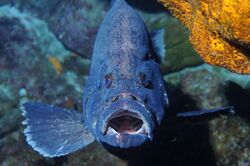Biology:Marbled grouper
| Marbled grouper | |
|---|---|

| |
| Scientific classification | |
| Domain: | Eukaryota |
| Kingdom: | Animalia |
| Phylum: | Chordata |
| Class: | Actinopterygii |
| Order: | Perciformes |
| Family: | Serranidae |
| Subfamily: | Epinephelinae |
| Genus: | Dermatolepis |
| Species: | D. inermis
|
| Binomial name | |
| Dermatolepis inermis (Valenciennes, 1833)
| |
| Synonyms[2] | |
| |
The marbled grouper (Dermatolepis inermis), donkey fish, mutton hamlet, rockhind and sicklefish grouper, is a species of marine ray-finned fish, a grouper from the subfamily Epinephelinae which is part of the family Serranidae, which also includes the anthias and sea basses. It is a predatory reef fish which is found in the Western Atlantic Ocean.
Description
The marbled grouper has a body which is at least twice as deep as its standard length[3] which is at its deepest at the origin of the dorsal fin and laterally compressed. It has a long snout and the dorsal profile of the head is steep.[4] The dorsal fin has 11 spines and 18-20 soft rays while the anal fin has 3 spines and 8-9 soft rays, the pectoral fin is large.[2] The adults are yellowish brown marked with numerous small dark brown spots on the head, body and fins and pale blotches on the head and body. The juveniles are dark brown through to black, marked with an irregular scattering of white blotches on the head and body.[4] It attains a maximum recorded total length of 91 centimetres (36 in) and a maximum weight of 10 kilograms (22 lb), although 50 centimetres (20 in) is a more common length.[2]
Distribution
The marbled grouper is found in the Western Atlantic Ocean from North Carolina south along the eastern coast of the United States to the Bahamas, in the Gulf of Mexico it is distributed from northwestern Cuba north to Alabama and the Flower Garden Banks, having also been recorded over salt domes in the United States territorial waters of the northern Gulf. In the Caribbean Sea it occurs from Cuba to Tobago, as well as Guanaja Island in Honduras. Off the coast of South America it is found from Santa Marta in Colombia to Guyana and then off Brazil from Sao Luis to Sao Paulo, including the Trindade and Fernando de Noronha Islands, Rocas Atoll, Parcel Manuel Luiz and Abrolhos Bank.
Habitat and biology
The marbled grouper normally occurs on deep ledges,[2] at depths between 3 and 250 metres (9.8 and 820.2 ft)[1] as well as on reefs, where it is usually found in caves or deep crevices. It is a solitary species which is secretie, nervously darting off when it is approached or threatened.[2] Its biology is little known but it is assumed that it forms aggregations for spawning like other groupers. The juveniles have been observed hiding among the spines of sea urchins.[1]
Taxonomy
The marbled grouper was first formally described as Serranus inermis in 1833 by the Frenchzoologist Achille Valenciennes (1794-1865) with the type locality given as the Antilles.[5]
Uitilisation and conservation
The marbled grouper has been described as being of little interest to fisheries but its flesh is esteemed in Brazil and it is sometimes taken by both anglers and commercial fisheries. Exploitation of spawning aggregations may me a threat to some populations. The IUCN classify it as Data Deficient due to a lack of information on its population. The population of this naturally rare and sparsely distributed species is, however, suspected to be decreasing.[1]
References
- ↑ 1.0 1.1 1.2 1.3 Ferreira, B.; Bertoncini, A.A. (2018). "Dermatolepis inermis". IUCN Red List of Threatened Species 2018: e.T39303A46914065. doi:10.2305/IUCN.UK.2018-2.RLTS.T39303A46914065.en. https://www.iucnredlist.org/species/39303/46914065. Retrieved 16 November 2021.
- ↑ 2.0 2.1 2.2 2.3 2.4 Froese, Rainer and Pauly, Daniel, eds. (2019). "Dermatolepis inermis" in FishBase. December 2019 version.
- ↑ Heemstra, P.C.; J.E. Randall (1993). FAO Species Catalogue. Vol. 16. Groupers of the world (family Serranidae, subfamily Epinephelinae). An annotated and illustrated catalogue of the grouper, rockcod, hind, coral grouper and lyretail species known to date. FAO Fish. Synopsis. 125. FAO, Rome. pp. 65–66. ISBN 92-5-103125-8. http://www.fao.org/3/t0540e/t0540e11.pdf.
- ↑ 4.0 4.1 "Species: Dermatolepis inermis, Marbled grouper". Shorefishes of the Greater Caribbean online information system. Smithsonian Tropical Research Institute. https://biogeodb.stri.si.edu/caribbean/en/thefishes/species/3483.
- ↑ Eschmeyer, William N.; Fricke, Ron; van der Laan, Richard, eds. "Serranus inermis". California Academy of Sciences. http://researcharchive.calacademy.org/research/ichthyology/catalog/fishcatget.asp?spid=20428.
Wikidata ☰ Q2696873 entry
 |


